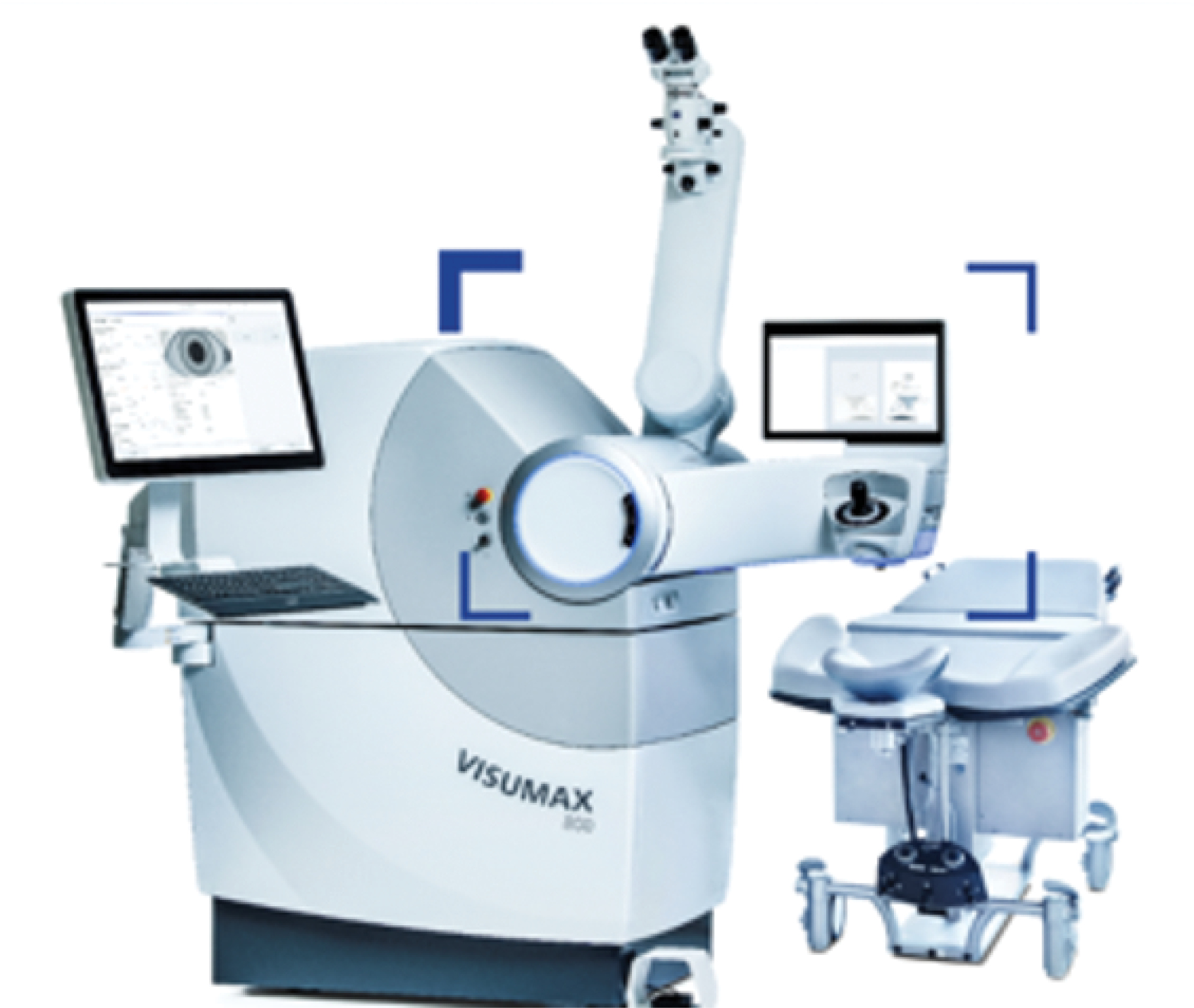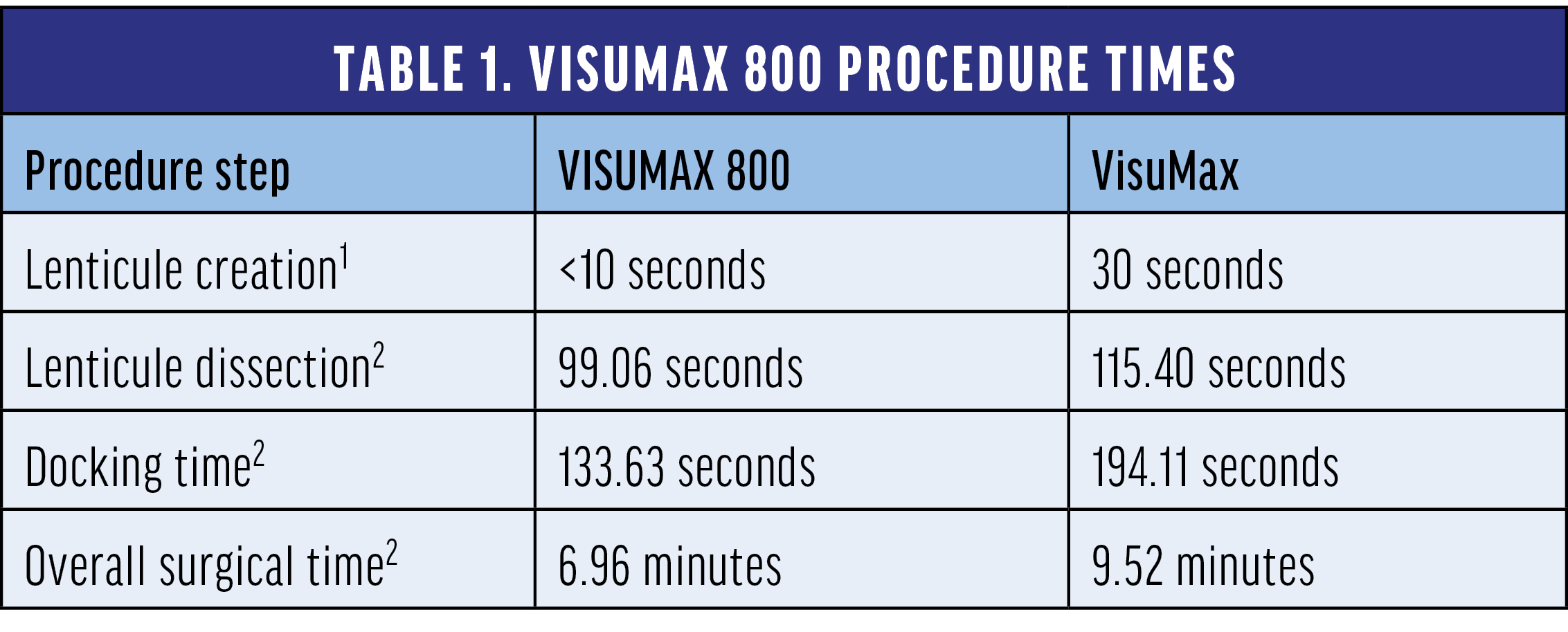Shortly after the U.S. FDA approved the VISUMAX® 800 from Carl Zeiss Meditec, a panel of refractive surgeons met to discuss the innovations that set this next-generation femtosecond laser apart (Figures 1 and 2). They first addressed how this advanced technology continues to achieve the excellent visual acuity outcomes they have come to expect and then discussed what this new laser will mean to their practice.

Figure 1. William F. Wiley, MD, (L) and Sonny Goel, MD, (R) at the 2024 Caribbean Eye Meeting.

Figure 2. The VISUMAX 800.
Comparable Outcomes
William F. Wiley, MD: As refractive surgeons, we’re accustomed to seeing improvements in efficacy when new lasers are introduced. What’s interesting about the VISUMAX 800 is that we’re not necessarily going to see a dramatic step forward in long-term efficacy. In fact, the lenticule profile and the laser delivery system are identical to those of the first-generation VisuMax laser. As for visual acuity, Reinstein and colleagues performed a retrospective analysis of 128 eyes of consecutive patients who had undergone small incision lenticule extraction with the VISUMAX 800.1 They found that the long-term visual acuity outcomes were equivalent to outcomes with the first-generation VisuMax laser.1 With that said, we expect to see a faster visual recovery within the first days to weeks after surgery. As we have seen with previous advancements in femtosecond lasers, faster laser speeds allow for lower energy settings and thus provide faster visual recovery.
What sets the VISUMAX 800 apart from its predecessor? Once we dig deeper, once we have it in our hands, the nuances that make this upgrade worthwhile will become apparent. Chief among them is the increased laser speed—2,000 kHz for the VISUMAX 800 versus 500 kHz for the original VisuMax—which is key to reducing surgery time and enhancing patient and surgeon comfort.
Faster Laser
Dr. Wiley: I believe anything we can do to enhance the patient experience will drive revenue to our bottom line. Imagine the impact of reducing surgery times by almost one-third.
In a prospective study of small incision lenticule extraction surgeries, Brar and colleagues compared the workflow of the VisuMax with that of the VISUMAX 800.2 They found that overall surgery time decreased from about 10 minutes with the VisuMax to 7 minutes with the VISUMAX 800 (Table 1). They opined that reduced docking and lenticule creation times played a major role in decreasing the overall surgery time with the VISUMAX 800.
Sonny Goel, MD: Indeed, Reinstein and colleagues found that lenticule delineation time with small incision lenticule extraction decreased from about 30 seconds with the VisuMax to less than 10 seconds with the VISUMAX 800 (Table 1).1 They attributed this result to the increase in pulse frequency from 500 kHz to 2,000 kHz.

What’s more, in a retrospective study of small incision lenticule extraction surgeries from 2010 to 2017 using the original VisuMax laser, Reinstein and colleagues found that the incidence of suction loss in more than 4,000 eyes was about 0.5% or 20 eyes.3 About 65% of those incidents occurred after 10 seconds. If the VISUMAX 800 enables us to create a complete lenticule in less than 10 seconds, then we are potentially looking at a suction loss rate of about 0.2%, or 8 eyes out of 4,000 eyes. Thus, in addition to reducing surgery time, the VISUMAX 800 may potentially reduce suction loss.
Enhanced Surgeon Comfort
Dr. Wiley: The VISUMAX 800 advancements that we’ve discussed thus far—comparable outcomes, less dissection time, potentially less suction loss, and reduced overall surgery time—all contribute to a surgeon’s comfort level. Dr. Goel, it appears there’s also an advantage with docking.
Dr. Goel: In the Brar study, overall surgery time was greatly reduced with the VISUMAX 800, and part of that had to do with docking time.2 Docking with the VISUMAX 800 is different from the IntraLase (AMO) and the WaveLight FS200 (Alcon). With those lasers, there is a separate suction ring on the eye, and the surgeon has to dock with the machine. With the VISUMAX 800, the one-piece interface descends, touches the cornea, and docks, all at one time.
Dr. Wiley: There’s another aspect of small incision lenticule extraction surgery that we don’t often hear about. I think we all probably subconsciously hold our breath while we’re lasering the lenticule, which right now is 20 to 30 seconds. We do it because we’re tense.
Dr. Goel: Absolutely. We may be doing that as often as 20 times in a day. That’s exhausting. But because lenticule creation is so fast with the VISUMAX 800, I’ll feel more relaxed at the end of the day.
I’d like to make another point about the VISUMAX 800. Right now, I need to move patients from the VisuMax to my excimer laser. With the VISUMAX 800, I won’t have to do that anymore; its profile is such that it can marry up with any excimer bed, fulfilling the requirements for a patient-supporting system.
Dr. Wiley: That’s a good point. Some LASIK surgeons may have concluded that the VisuMax looked great, but there was no way it would fit in their OR. The VISUMAX 800 will fit in any room next to any bed. I think even LASIK surgeons who have no interest in lenticule surgery will benefit from having a VISUMAX 800. Certainly, they should consider it. The VisuMax, when used for LASIK flaps, is more comfortable for patients than other femtosecond lasers because patients maintain vision, and there isn’t the high rise in IOP. The VISUMAX 800 is not approved for LASIK flaps in the United States.
Enhanced Patient Comfort
Dr. Goel: When patients come in for a refractive surgery consultation, there are two barriers that may prevent them from going ahead with a procedure. Number one is finance, so we offer them the option of 24-months-same-as-cash financing to make it easier for them to afford. Number two is fear. How can we help them overcome their fear objections?
When I discuss small incision lenticule extraction with patients, I explain that it’s a comfortable procedure, they’ll maintain vision, and they won’t feel the pressure. Now, I can also tell them about our new, fast laser that can create a lenticule in just <10 seconds, so that the entire surgery is completed before most patients even realize it. When patients consider these factors, I believe their fears will be minimized and they’ll be more likely to move forward with small incision lenticule extraction surgery.
Dr. Wiley: Taken together, the various innovations incorporated into the VISUMAX 800 equate to an enhanced patient experience.
Dr. Goel: Yes, the potential for reduced patient anxiety is huge. The best part about that is that these patients are going to send us referrals. They’re going to tell their friends they had small incision lenticule extraction surgery, and when their friends ask, “How was it?” no doubt they’ll say, “That was easy.”
As I tell my staff, that one happy patient is worth $15,000 in revenue (the $5,000 they’re paying at the time, plus two referrals). We have to make the experience better for our patients if we want to generate more referrals.
Summary
Dr. Wiley: The VISUMAX 800 laser incorporates some remarkable technological advances while enabling us to deliver small incision lenticule extraction outcomes that are comparable to what we achieve with the first-generation VisuMax laser, only faster and without compromising safety.
While we, as refractive surgeons, appreciate the benefits of this advanced technology in the OR, we can not underestimate the impact of the patient experience. I believe that remains the key to our overall success.
1. Reinstein DZ, Archer TJ, Potter JG, Gupta R, Wiltfang R. Refractive and Visual Outcomes of SMILE for Compound Myopic Astigmatism With the VISUMAX 800. J Refract Surg. 2023;39(5):294-301.
2. Brar S, Ganesh S, Bhargav S. Comparison of Intraoperative Time Taken for Docking, Lenticule Dissection, and Overall Workflow for SMILE Performed With the VisuMax 800 Versus the VisuMax 500 Femtosecond Laser. J Refract Surg. 2023;39(9):648.
3. Reinstein DZ, Archer TJ, Vida RS, Carp GI. Suction stability management in small incision lenticule extraction: incidence and outcomes of suction loss in 4000 consecutive procedures. Acta Ophthalmol. 2020;98(1):e72-e80.
4. Patient and surgeon experience during LASIK using 2 femtosecond lasers. Reece Hall. JCRS. 2014
5. IOP during flap creation for 4 femtosecond lasers . Jan Vetter, Walter Sekundo. JRS. 2011



